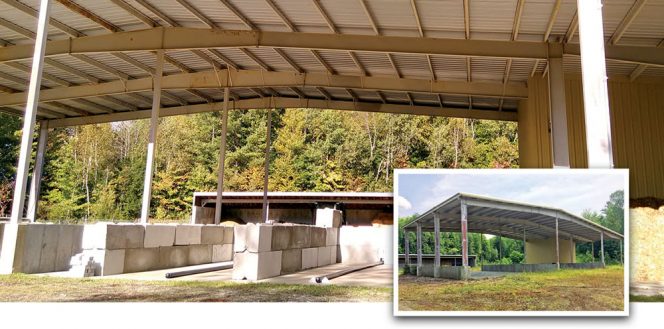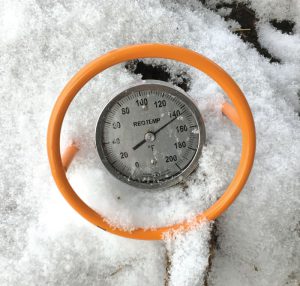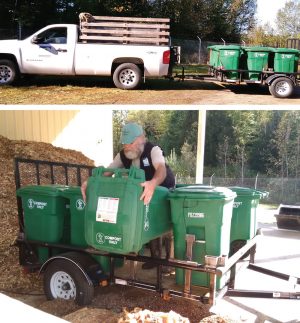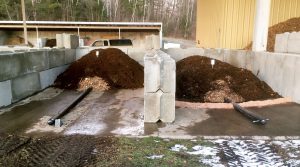A Vermont solid waste district utilized a defunct biosolids composting site to create capacity for processing food waste.
Marsha W. Johnston
BioCycle May 2018

The original composting structure (inset) was retrofitted to house 3 primary and 2 secondary aerated static pile (ASP) bays with concrete block walls (left). Photo courtesy of Lamoille Regional Solid Waste Management District
Luckily, LRSWMD had an ace in the hole. In the early 1990s, the Village of Johnson in the District had built a facility to compost biosolids as part of a wastewater treatment upgrade. Funded by federal and state monies, the 2-acre fenced site had an 88-foot by 122-foot covered concrete pad, a heated workshop, and a three-sided, roofed shed for storing carbon feedstocks.
The facility “had been abandoned for a long time,” says Alexander. “We knew it existed because we operate a transfer station next door. We knew the infrastructure was there, and not being used, and it was an attractive opportunity to get into the composting business without spending a great deal of money.”
In June 2016, a year before its deadline to accept food waste, LRSWMD applied for a $75,000 grant from Northern Borders Regional Commission (NBRC), a Federal-State partnership established by the U.S. Congress in 2008 to provide economic and community development funds for the most distressed counties of Maine, New Hampshire, Vermont, and New York. One of six such regional commissions created in the last 20 years, NBRC provides matching funds to grant applicants.
LRSWMD was awarded $50,000, but decided to maintain its originally required match of $75,000, explains Alexander. “These are extremely competitive grants; only 14 were awarded in Vermont. It provides economic development dollars to jumpstart job creation. We have invested a total of just under $125,000.”
With the grant in hand by October 2016, LRSWMD began negotiating with the Village of Johnson and Town of Johnson. The village, which owned the facility infrastructure and runs the electric, water and sewer, immediately granted permission, while the town, which owned an old unlined landfill underneath the infrastructure, required a longer negotiation.
Site Renovations
Renovation for the future site of the Lamoille Soil Composting Facility began in June 2017. “Trees had grown up, so we had to remove them and a lot of brush, and make minor repairs to buildings, including the plumbing that had been stripped out by vandals,” notes Alexander.

The ASP system maintained composting temperatures throughout the winter months. Photo courtesy of Lamoille
Regional Solid Waste Management District
On the covered concrete pad, LRSWMD built three primary and two secondary aerated static pile bays with concrete blocks and, opting not to cut into the existing concrete pad, laid perforated pipes on top of the pad. The piping system is manifolded to a series of fans controlled by a panel in the workshop where the operator can manage the air flow and volume in each bay.
In May 2017, LRSWMD hired Chris Duff, former Manager for the Highfields Center for Composting, to operate the site, which has the capacity to accept between 8 to 10 tons/week of food scraps. A number of other feedstocks are used in the composting recipe, including wood chips and saw chips, sawdust, old hay, manure, leaves and yard clippings.

The Lamoille solid waste district manages 6 drop-off sites where households bring food scraps and unload them into 48-gallon totes. Once a week, Lamoille Soil collects the totes using a pickup truck and trailer (top), and unloads them at the composting facility (above). Photos courtesy of Lamoille Regional Solid Waste Management District
Educating Households
The District also had to figure out how best to engage its 26,000 residential customers about food scrap composting that would begin July 1, 2017. “Before July, the only organics diversion we had was backyard composting, but that doesn’t work for everyone, so we had to provide a drop-off solution,” Alexander explains.
With a $10,000 grant from The High Meadows Fund, LRSWMD created compost kits that included refrigerator magnets and 5-gallon buckets with screw-top lids. Each bucket sported the Lamoille Soil logo and listings of what could be put into the food scraps bucket. Close to 200 kits were given away free to households as part of the kick-off campaign; now they are for sale for $15 at all LRSWMD locations. The grant also funded direct mailings to everyone in the district, notifying them of the start of the organics collection program on July 1, 2017, and where they could dump their bucket — for a $1.00 fee — at any of the District’s six drop-off locations.
The new Lamoille Soil Composting Facility wasn’t quite ready to begin composting food waste when the state’s deadline came. So from July 1 through the end of September 2017, LRSWMD contracted a private farm composter about 40 miles away to pick up and process the food scraps. “We were paying $20 per 48-gallon tote to pick up and transport it farther than we wanted,” Alexander notes.
By October 1, the composting site was completely renovated and began taking food scraps, and the fully featured Lamoille Soil regional organics collection and composting program was born. Once a week, with a pickup and trailer, Duff brings the 48-gallon totes from the six sites to the new facility.

Perforated pipes on top of the concrete pad are manifolded to a series of fans. The site has capacity to compost 8 to 10 tons/week of food scraps. Photo courtesy of Lamoille Regional Solid Waste Management District
The residential drop-off is Lamoille Soil’s top priority because the region’s big commercial generators like Hannaford Supermarkets and Stowe Mountain Resort have commercial haulers and composters that manage their organics., Alexander says. But, she adds, “some commercial haulers are looking to do more collection in our region, and are asking if they can bring food waste to our facility. We’re working on rate sheets and figuring out how much we can take.”
Lamoille Soil expects to have finished compost to sell by late spring. Initially, it will be available at the facility by a cubic yard minimum. LRSWMD also plans to work with regional member towns to use it in municipal projects. “This is just the beginning of what we hope to accomplish through Lamoille Soil,” notes Alexander. “Once we have the first year of data to analyze, we will be able to better plan for further expansion of services offered and products for sale.”
Marsha W. Johnston, an editor with Earth Steward Associates, is a Contributing Editor to BioCycle.










